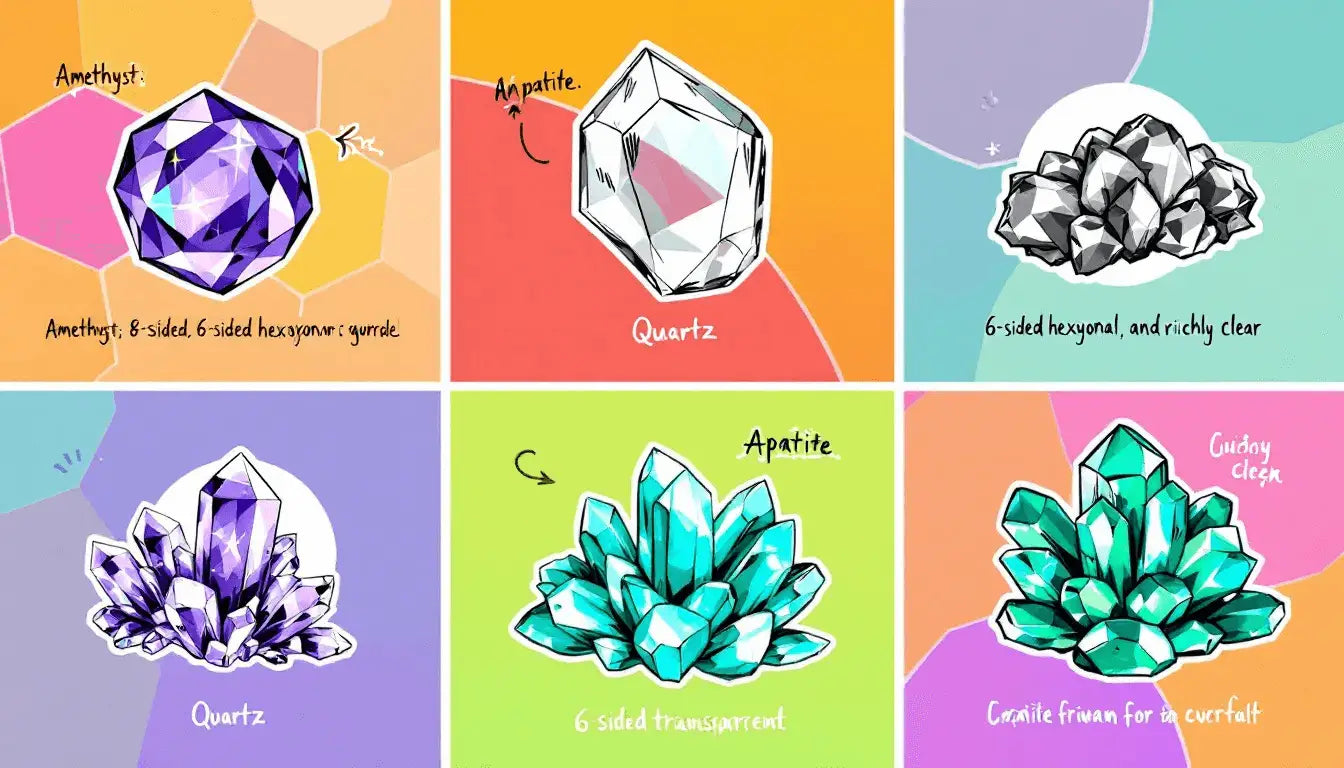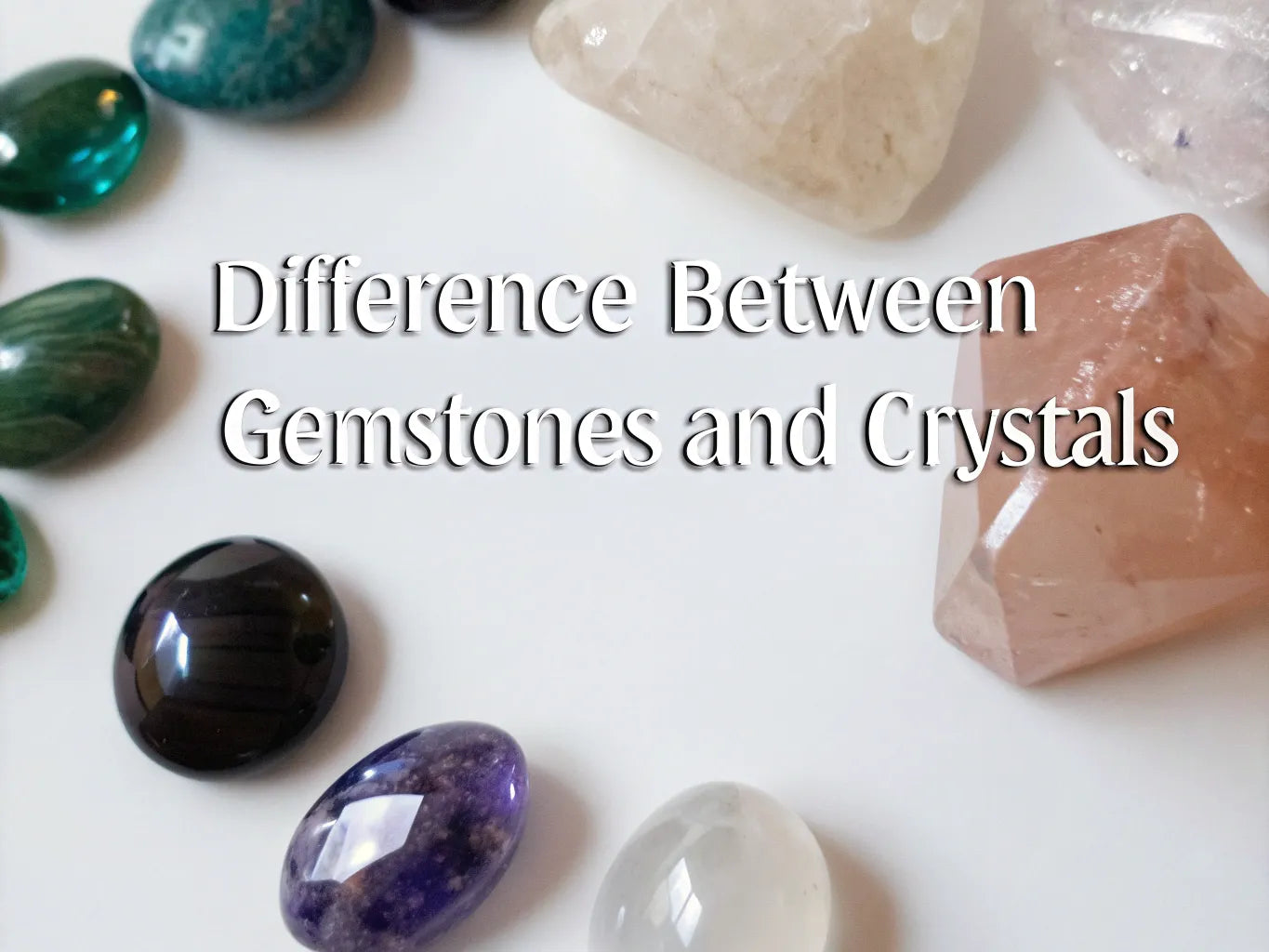The difference between gemstones and crystals lies in their formation and use. Gemstones are minerals cut and polished for aesthetics, often used in jewelry. Crystals are natural substances with a defined atomic structure and internal structure, used in various applications from healing to electronics. This article explores their unique properties, formation processes, and uses.
Key Takeaways
-
Crystals are defined by their three-dimensional atomic structures and symmetry, while gemstones are cut and polished minerals valued for their aesthetic appeal and use as decorative objects.
-
The value of gemstones is determined by the ‘four Cs’ (color, clarity, cut, carat weight) and their rarity, surpassing the typical value of crystals.
-
Both crystals and gemstones serve various purposes in jewelry, metaphysical practices, and industry, emphasizing the importance of ethical sourcing and sustainability.
Understanding Crystals

Crystals are magnificent structures that captivate with their symmetry and brilliance. At their core, crystals are pure substances with a three-dimensional atomic lattice that gives them their unique shapes and properties. This highly ordered arrangement of solid material, atoms, molecules, and ions forms the basis of their stunning geometric patterns.
Crystals can be naturally occurring or synthesized in laboratories through crystallization. Examining their structure, formation processes, and types provides a deeper understanding of these fascinating substances.
Crystal Structure
Crystals are characterized by a symmetrical, repeating arrangement of atoms, leading to various shapes from simple cubic forms to intricate hexagonal patterns. This internal arrangement defines the overall shape and properties of each crystal.
Crystals are classified into seven distinct crystal systems. These include:
-
Cubic
-
Tetragonal
-
Trigonal
-
Triclinic
-
Hexagonal
-
Monoclinic
-
Orthorhombic
Each system represents a unique way in which the atoms are arranged, contributing to the diversity of crystal forms found in nature. For instance, quartz is known for its hexagonal system, while common salt (halite) forms cubic crystals.
Formation Process
Crystals form through a fascinating process known as crystallization, which can occur in several ways. They can crystallize from cooling magma, freezing water, or the evaporation of a solution. When molten rock cools, the atoms within it begin to arrange themselves into a solid, crystalline structure.
Similarly, when water evaporates, the minerals dissolved in it can precipitate out, forming crystals over time.
Types of Crystals
Crystals are categorized based on their atomic bonds into four primary groups:
-
Covalent
-
Ionic
-
Metallic
-
Molecular
Each type has distinct properties and structures, contributing to the wide variety of crystals found in nature.
Appreciating the complexity and beauty of these types also highlights their practical applications.
Defining Gemstones
Gemstones are the epitome of nature’s artistry, defined as rare Earth substances that include minerals, rocks, or organic matter polished for ornamental purposes. Unlike crystals, a gemstone undergoes cutting and polishing to enhance its aesthetic appeal, making it highly valued in fine jewelry and other decorative objects.
Gemstones and crystals differ in appearance and rarity. Gemstones are classified into precious stones like diamonds and rubies, and semi-precious stones such as amethyst and quartz.
This section will explore the characteristics of gemstones, the differences between natural and synthetic varieties, and provide examples of both precious and semi-precious stones.
Characteristics of Gemstones
High-grade gemstones, prized for their purity and beauty, are ideal for fine jewelry. Their value is determined by rarity, beauty, durability, and cut precision. Unlike crystals, gemstones are classified by the ‘four Cs’: color, clarity, cut, and carat weight.
The superior attributes of gemstones generally surpass those of crystals, making them more desirable for ornamental purposes. This distinction is why many gemstones are more expensive and sought after compared to crystals.
Natural vs. Synthetic
Natural gemstones form under high pressure and temperature conditions in the Earth’s crust, resulting in unique inclusions and variations. In contrast, synthetic gemstones are created in laboratories, mimicking these natural conditions but typically resulting in stones with fewer inclusions and more vibrant colors.
Although chemically similar, synthetic gemstones are generally valued less than natural ones due to their controlled formation process.
Examples of Gemstones
Precious gemstones include diamonds, rubies, sapphires, and emeralds, each with unique properties. For example, rubies owe their red color to corundum.
Semi-precious gemstones such as quartz, topaz, tourmaline, and amethyst also hold significant value and beauty. Additionally, non-mineral materials like opal and pearl are classified as gemstones due to their unique appearances and uses in jewelry. It’s worth noting that some semi-precious gemstones can be more expensive than precious ones due to factors like rarity and demand.
Main Differences Between Gemstones and Crystals

Gemstones and crystals primarily differ in formation, structure, and valuation. Crystals form when atoms arrange in a repeating pattern, creating a specific structure. Gemstones, typically minerals, are cut and polished for enhanced beauty and valued for rarity and aesthetic properties.
Not all crystals are classified as gemstones due to lacking desired aesthetics or rarity. Additionally, while crystals can be lab-synthesized, gemstones are often distinguished by their natural or synthetic origins.
Atomic Arrangement
Crystals are composed of three-dimensional lattices formed by atoms, ions, and molecules, creating a highly ordered structure. This repeating arrangement defines the crystal lattice and contributes to the unique properties of each crystal. For instance, the hexagonal structure of quartz is a result of its specific atomic arrangement.
This atomic arrangement classifies crystals into seven systems: cubic, tetragonal, trigonal, triclinic, hexagonal, monoclinic, and orthorhombic. Each system represents a unique atomic arrangement affecting the crystal’s shape and properties.
Classification Criteria
Crystals are classified based on their crystal systems, while gemstones are categorized as precious or semi-precious based on commercial context and properties such as:
-
refractive index
-
luster
-
specific gravity
-
hardness
-
clarity
-
dispersion
-
fracture
Lab-created gemstones, though chemically identical to natural ones, are generally valued less due to their synthetic origin.
Value and Rarity
The value of gemstones often exceeds that of crystals due to their unique visual appeal and limited availability. Many gemstones, such as rubies and diamonds, are more expensive than crystals because of their rarity and brilliance.
Non-mineral materials such as lapis lazuli, opal, amber, jet, and pearl are classified as gemstones due to unique properties and high value. High-quality gemstones often come from ethical sources, reflecting superior craftsmanship and responsible practices.
Applications and Uses
Crystals and gemstones are not just beautiful; they serve purposes across various fields, from fine jewelry to industrial applications.
This section will explore their uses in jewelry and decoration, metaphysical and healing practices, and scientific and industrial applications.
Jewelry and Decoration
Gemstones and crystals are widely used in jewelry and decoration. Crystals adorn jewelry articles, with lab-grown varieties common in artificial pieces. Beyond jewelry, crystals enhance the aesthetic appeal of homes and offices.
Crystals are popular in meditation practices, believed to enhance focus, clarity, and relaxation. Their beauty and perceived metaphysical properties make them favorites in personal and professional spaces.
Metaphysical and Healing
Many cultures believe in the healing properties of gemstones, using them in rituals to restore energy and promote emotional well-being. Different crystals are thought to possess unique spiritual properties aiding in healing and emotional balance.
For instance, amethyst is often associated with spiritual growth and emotional stability.
Scientific and Industrial Uses
Crystals play essential roles in modern technology, including electronics and optics. Quartz crystals provide precise frequency control in the semiconductor industry, while diamonds are used in cutting tools due to their unparalleled hardness.
Sapphire crystals are also used in electronic components for their durability and ability to withstand high temperatures.
Ethical Considerations
Ethical sourcing of gemstones and crystals is crucial for preserving the environment and ensuring fair labor practices. Reputable sources prioritize sustainability and ethics in sourcing these materials.
This section will discuss ethical sourcing practices, their impact on communities, and how to recognize quality gemstones and crystals.
Ethical Sourcing Practices
Ethical sourcing practices involve obtaining gemstones and crystals from reputable sources prioritizing sustainability and ethics. Certification schemes like the Kimberley Process ensure responsible sourcing, minimizing negative effects on the environment and communities.
Impact on Communities
Ethical sourcing promotes social responsibility and improves the livelihoods of local mining communities. It supports fair trade, ensuring miners receive adequate wages and work under safe conditions.
This benefits both communities and fosters a sense of social responsibility among consumers.
Recognizing Quality
Recognizing quality in gemstones and crystals ensures value and beauty in purchases. Organizations like the Rupani Foundation provide quality testing and certification, helping consumers make informed choices. Ethically sourced materials often exhibit higher quality due to responsible mining practices and artisan methods.
Summary
In summary, gemstones and crystals, while often confused, possess distinct differences in their formation, structure, and value. Crystals are defined by their highly ordered atomic arrangement, forming various geometric structures. Gemstones, on the other hand, are valued for their beauty, rarity, and the enhancements they undergo through cutting and polishing.
Understanding these differences allows us to appreciate the unique qualities of each and make informed choices whether for jewelry, decoration, or industrial use. As ethical considerations become increasingly important, sourcing gemstones and crystals responsibly ensures their beauty is cherished in a sustainable and socially responsible manner.
Frequently Asked Questions
What defines a crystal?
A crystal is defined by its highly ordered structure, characterized by a three-dimensional atomic lattice that consists of pure substances. This distinct arrangement gives crystals their unique properties.
How are gemstones different from crystals?
Gemstones are polished and valued for their beauty and rarity, whereas crystals are assessed based on their natural shape and luster. The primary difference lies in the treatment and value attributed to them.
What are some examples of precious gemstones?
Precious gemstones include diamond, ruby, sapphire, and emerald. These stones are highly valued for their beauty and rarity.
Why are synthetic gemstones valued less than natural ones?
Synthetic gemstones are valued less than natural ones because they are produced through a controlled process, leading to fewer inclusions and more uniform colors, which diminishes their rarity and perceived uniqueness.
What is the importance of ethical sourcing in gemstones and crystals?
Ethical sourcing of gemstones and crystals is crucial as it protects the environment and upholds workers' rights, fostering social responsibility and sustainability in the industry. By prioritizing ethical practices, consumers can contribute to positive change.



Share:
October Birthstones: All About Opal and Tourmaline
Which Is the Birthstone for February? Its Amethyst